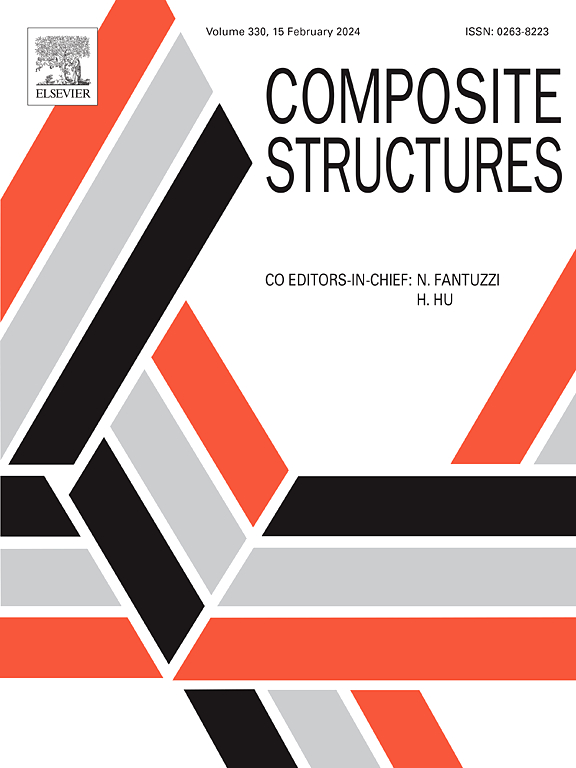对不等极开口复合压力容器进行多目标优化
IF 6.3
2区 材料科学
Q1 MATERIALS SCIENCE, COMPOSITES
引用次数: 0
摘要
针对用于储水和加热水的内压包覆复合材料压力容器提出了多目标参数优化问题。该问题使用开发的迭代优化算法求解。通过改变复合材料层的一组参数,如层厚度和极开口半径,可获得容器设计参数的最佳值,这些参数会影响沿容器的纤维角分布。建议的优化方法以复合材料容器的机械解决方案和满足主要失效标准为基础。一种创新的方法在于,可以使用所开发的优化方法来设计非对称纤维缠绕的容器,这种容器的穹顶上有不相等的极性开口。之所以能做到这一点,是因为开发了一种特殊的复合材料容器数值机械有限元模型。一个特定的 Python 程序可以创建模型,并控制迭代优化过程中各模块之间的数据交换。数值模型包括确定容器圆顶和圆柱部分的纤维角分布以及层厚度的变化。优化问题的解决方案采用多岛遗传算法,这种方法可以避免局部求解,显示了其在此类应用中的效率。因此,通过使复合材料质量和厚度最小化以及应变能最大化,找到了复合材料容器的最佳参数。针对三种类型的复合材料,介绍了使用所开发方法的测试解决方案,以评估将其集成到容器设计模型中的可能性。本文章由计算机程序翻译,如有差异,请以英文原文为准。
Multi-objective optimization for a composite pressure vessel with unequal polar openings
Multi-objective parametric optimization problem is presented for overwrapped composite pressure vessels under internal pressure for storage and heating water. It is solved using the developed iterative optimization algorithm. Optimal values of design parameters for the vessel are obtained by varying the set of parameters for composite layers, such as the thickness of layers and radii of polar openings, which influence the distribution of fiber angles along the vessel. The suggested optimization methodology is based on the mechanical solution for composite vessels and the satisfaction of the main failure criteria. An innovative approach lies in the possibility of using the developed optimization methodology for designing vessels with non-symmetrical filament winding, which have unequal polar openings on the domes. This became possible due to the development of a special numerical mechanical finite element model of a composite vessel. A specific Python program provides the creation of a model and controls the exchange of data between the modules of the iterative optimization process. The numerical model includes the determination of the distribution of fiber angles on the domes and cylindrical part of the vessel as well as changes in layer thicknesses. The optimization problem solution is provided using a Multi-Island Genetic Algorithm, this type of method showed its efficiency for such applications, by allowing to avoid local solutions. Thus, optimal parameters of a composite vessel were found by minimizing composite mass and thickness and maximizing the strain energy. Test solutions using the developed methodology are presented for three types of composite materials to evaluate their possibility for integration into the vessel design model.
求助全文
通过发布文献求助,成功后即可免费获取论文全文。
去求助
来源期刊

Composite Structures
工程技术-材料科学:复合
CiteScore
12.00
自引率
12.70%
发文量
1246
审稿时长
78 days
期刊介绍:
The past few decades have seen outstanding advances in the use of composite materials in structural applications. There can be little doubt that, within engineering circles, composites have revolutionised traditional design concepts and made possible an unparalleled range of new and exciting possibilities as viable materials for construction. Composite Structures, an International Journal, disseminates knowledge between users, manufacturers, designers and researchers involved in structures or structural components manufactured using composite materials.
The journal publishes papers which contribute to knowledge in the use of composite materials in engineering structures. Papers deal with design, research and development studies, experimental investigations, theoretical analysis and fabrication techniques relevant to the application of composites in load-bearing components for assemblies, ranging from individual components such as plates and shells to complete composite structures.
 求助内容:
求助内容: 应助结果提醒方式:
应助结果提醒方式:


